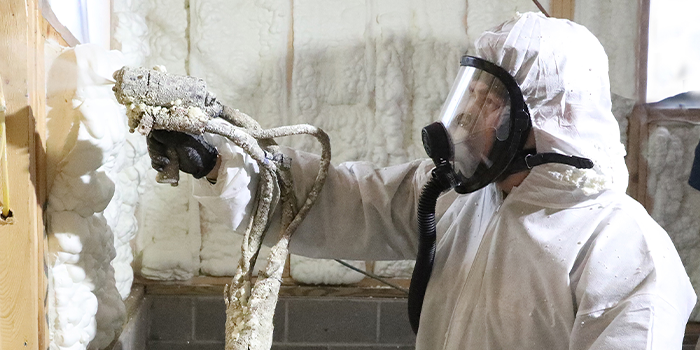
The Great Air Barrier

Spray Foam Magazine – Spring 2021 – Air barriers are designed to control airflow, heat, and moisture, as well as solar and other radiation in a building. All of which can have an effect on air quality, as well as a building’s long-term structural performance. Now, more than ever, air barriers are taking center stage in construction, architecture, and public health performance, but how can spray foam help advancements in air barriers which are necessary to improve indoor air-quality?
CDC research indicates people with the recent COVID-19 virus can eject infectious aerosols, which are tiny viral droplets, when they talk, cough, and exhale. These microscopic droplets have the potential to travel a distance of multiple meters. People breathing in the same air, inhale those particles and can either get sick with COVID-19 or pass it on to someone else. According to this research paper, the Middle East respiratory syndrome (MERS) and the flu can also be spread through microdroplets that can potentially travel far distances indoors and be inhaled.
Once the pandemic is under control, people will once again be entering the office space. Surfaces will be touched by various individuals entering the building and this one fact will also help the transmission of viruses. In mechanically ventilated buildings there is also recirculation of some amount of air, so having high-efficiency filters will help prevent the virus transmission from room to room.
Historically, during and after a pandemic, there are big advancements in science that impact how we all live. This includes investigations and advancements in building science and construction with a race for the science world to control disease spread and the construction world to help manage it with implementing the ‘healthy building’ design and structure.

Spray foam can help strengthen the structure of a building, creating a monolithic air seal that stops unwanted air leakage and separates the cold environment from the warm environment, which means that condensation should not occur. With a proper performing building envelope, the occupants are not subject to airborne pollutants.
Laverne Dalgleish, the Executive Director of the Air Barrier Association of America (ABAA) offers an example, “For the buildings to be healthy, they need to perform as intended and not create an environment where the building would be subject to conditions which would cause mold, rot, mildew, or corrosion. SPF strengthens the structure of the building, creates a monolithic air seal stopping unwanted air leakage and separates the cold environment from the warm environment, which means that condensation will not occur—stopping mold, mildew, rot, and corrosion. Most moisture damage results in air leaking into or out of the building, then condensation in the building envelope. Living in a building that has moisture problem provides an incubator for all kinds of spores to be floating around.”
On April 14, 2020, the American Society of Heating, Refrigerating and Air-conditioning Engineers Position Document (ASHRAE PD) announced to offer assistance to lessen disease transmission and as a reference point for building readiness for post-pandemic return to operation.
The ASHRAE PD recommends increased ventilation but this alone is not capable of addressing all aspects of infection control, changes to building operations, including the mechanical systems which can help reduce airborne exposures. The ASHRAE PD does not make a conclusive endorsement on indoor temperature and humidity set points for the purpose of controlling infectious aerosol transmission. It does however offer immunologists concurrent humidity levels with improved immunity against respiratory infections and unfavorable survival rates for microorganisms when the relative humidity (RH) is between 40 and 60 percent. The research also shows a correlating increase in infections when the interior environmental conditions fall below the 40 percent.
Architect Hafsa Burt, is the founder of hb+a Architects and has been a pioneer of Healthy Buildings and Environmental Sustainability before the terms were industry norms, having been involved in initiating green building ordinances and design standards since 2006. Burt comments on the use of SPF in a Healthy Building design, “Since the oil embargo of the 1970s there has been a push to make our buildings air-tight to conserve energy on heating and cooling loads. Safe installation is of prime importance in spray foam insulation and making sure it is installed by a professional that offers a safe application. Proper ventilation is key to allow a healthy dose of clean outdoor air. Closed-cell polyurethane spray foam is now approved as an exterior air and vapor barrier. It does have to be of medium density to work as an air barrier. Air barriers in general when applied to the exterior, limit the flow of humidity.”
As an insulator SPF can help reduce and even prevent dew point conditions. Humidity needs to be averted to help stop issues, such as mold and ‘unhealthy’ air to be abolished. Certified spray foam installers and trade associations, such as the Spray Polyurethane Foam Alliance and the Air Barrier Association of America, have in recent years developed intensive SPF installer certification programs focusing on safety, installation technique, and in-field quality verification testing. Manufacturers have additionally created training programs exclusive to their product lines. These certifications and training methods can be incorporated into the design and implementation of a sophisticated SPF application and to help avoid such circumstances as humidity.
ABAA’s Laverne Dalgleish closes by saying, “With a proper performing building envelope, the occupants are not subject to airborne pollutants. People suffer from the indoor environment being too dry or too wet and SPF helps separate the outdoors from the indoors. This means the cold dry air, or the hot humid air is kept out allowing the right conditions inside. Many people suffer from allergies caused by pollen, dust, tiny insects, etc. and with the SPF expanding into every nook and cranny, creating an air barrier, these are sealed out. Where people occupy a unit in the building, pollutants from a neighbor can seep into their unit and cause an unhealthy living condition. Almost anything can be transported by air from second-hand cigarette smoke to viruses.”
By combining the knowledge of industries like, ASHRAE, spray foam, architecture and immunobiology, the structure and effect on air quality of a building, and therefore the people within it, has the potential to get a whole lot healthier.













